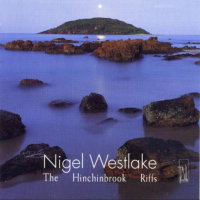
Superlative Performances
Nigel Westlake's
'The Hinchinbrook Riffs' -
recommended by
MALCOLM TATTERSALL'... essential listening for anyone interested in new music.'
|

|
The career of Nigel Westlake began twenty years ago with Omphalo Centric Lecture (1984) and has developed steadily on several fronts since that auspicious beginning. His many film scores include Babe, its sequel and several Imax films; his orchestral music includes, recently, his Antarctica Suite for guitar and orchestra; and there has been a steady trickle of chamber music, often featuring guitar, percussion or his own instrument, the clarinet.
Which brings us to The Hinchinbrook Riffs, an anthology of his more recent and more significant chamber works: five compositions, four of them dated between 2003 and 2005.
The title track reached its final form in 2003 but, according to the composer's liner notes, its origins lie as far back as 1975 when Westlake first visited the island. Now an eight-minute piece for guitar and digital delay, its rippling figurations beautifully evoke the waters of the island it is named for, endlessly changing and endlessly the same. It was, incidentally, recorded by Tim Kain in 2004 on Mirrors of Fire alongside the aforementioned Antarctica Suite and new works for guitar by other Australian composers.
Listen -- Nigel Westlake: The Hinchinbrook Riffs
(track 4, 0:00-0:46) © 2006 Tall Poppies Records
Kalabash (2004), for four players at two marimbas, has a similarly relaxed, breezy mood and is almost the same length. Its infectiously happy swing will immediately say 'jazz' to most listeners but the composer explains that its roots are actually in West African folk music for balofon, making it a distant cousin to jazz and a younger sibling to Omphalo Centric Lecture.
The other three pieces are much more intense, much more closely argued, and significantly longer. They are far more Eurocentric than stereotypically Australian (compare them with Red Earth, for instance) and, with them, Westlake meets the giants of the early twentieth century on their own ground. All three are performed here by the people who commissioned them and the recordings were produced by the composer. Is that how you spell 'definitive'?
The Piano Trio (2003) opens casually but the drama builds very quickly before unwinding towards its opening mood. The long slow second movement is another arch shape emotionally; it begins meditatively but tensions inexorably emerge and build to shrieking fury before resolving. The finale breaks into barbaric dance rhythms and segues through contrasting episodes before ending as diffidently as the first movement began.
Listen -- Nigel Westlake: Third movement (Piano Trio)
(track 3, 2:49-4:26) © 2006 Tall Poppies Records
The String Quartet No 2 (2005), fractionally longer at 23 minutes, is nominally in the four classical movements, fast-scherzo-slow-fast. The first movement, however, opens with a slow introduction and ends with a slow, lightly accompanied viola solo which could have stood alone, and the fourth movement opens with a two-minute continuation of the lovely third movement before breaking into the fast, strongly accented finale proper.
Listen -- Nigel Westlake: First movement (String Quartet No 2)
(track 5, 0:56-2:07) © 2006 Tall Poppies Records
The 1997 Piano Sonata can now be seen as a forerunner of these two rather than an isolated, uncharacteristically abstract work. The first movement (not so identified, but the divisions are clear) is fast, unsettled, toccata-like.
Listen -- Nigel Westlake: First movement (Piano Sonata)
(track 10, 0:01-0:57) © 2006 Tall Poppies Records
The second movement is spacious -- a sky full of brilliant stars -- and the third is quite short, a frenzied outburst reflecting and resolving the first.
Listen -- Nigel Westlake: Third movement (Piano Sonata)
(track 10, 11:19-12:19) © 2006 Tall Poppies Records
Westlake's experience as a composer for film is apparent, even in these most classical of instrumentations, in his total mastery of colour and texture, and perhaps that mastery is one reason these works remind me of Bartók and Stravinsky more than of other composers. The string quartet does everything that a quartet should, then their sound just grows again to orchestral fullness; in the Piano Trio, violin, cello and piano meld into timbral units that sound like new instruments.
Every piece on Hinchinbrook Riffs is rewarding, but the disc as a whole is marginally less so. The second and fourth works were presumably intended as points of relaxation between tougher, more complex major works but they can, for just that reason, feel out of place. At least modern CD players let one keep them separate to be enjoyed on their own terms.
Presenting 75 minutes of superlative performances of recent major works by one of Australia's leading composers, this disc is essential listening for anyone interested in new music.
Copyright © 5 November 2008
Malcolm Tattersall, Townsville, Australia
 BUY CLASSICAL CDS ONLINE
CD INFORMATION: NIGEL WESTLAKE - THE HINCHINBROOK RIFFS
BUY CLASSICAL CDS ONLINE
CD INFORMATION: NIGEL WESTLAKE - THE HINCHINBROOK RIFFS
| 
